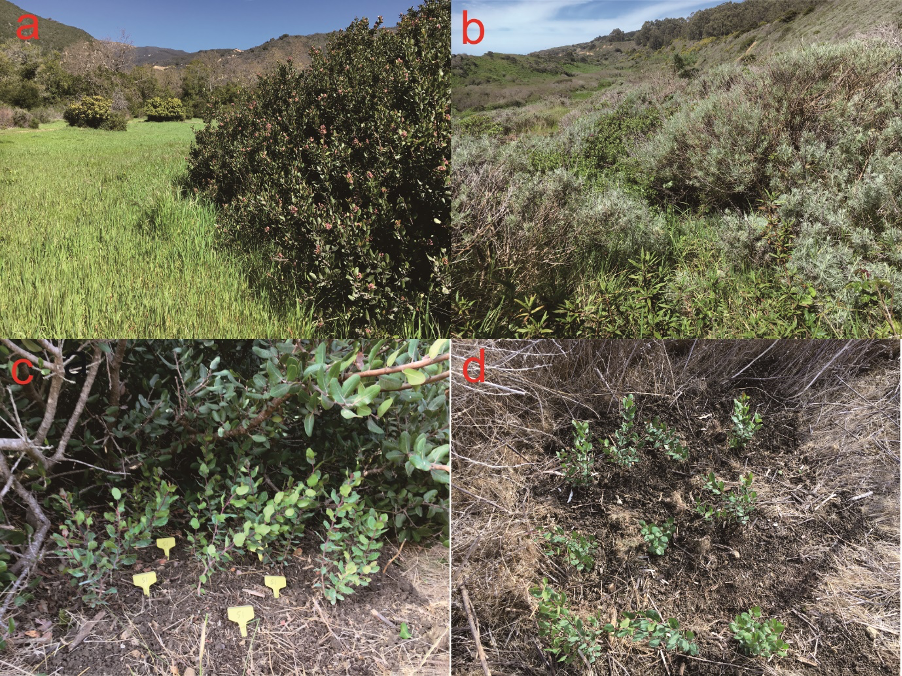
Feel free to contact Heng at henghuang @ berkeley. edu if you have questions or comments regarding the content here.
At the time when he left China to start his doctoral studies in the USA Heng Huang didn’t know that the plans had changed: We were about to move to the Pacific coast. It was probably like a cold shower and I still don’t know what his preference would have been. We will never know that because he is extremely accommodating, resilient, and capable of adapting to a changing environment. Indeed, adaptation to environmental change is something he knows very well and has become the focus of his research.
Heng joined our research group in Fall 2016 after having received a B.S. and a M.S. in Ecology from Lanzhou University. For his Ph.D. he investigated climate change impacts on ecosystem resilience through a combination of experimental and modeling approaches. Specifically, he studied the way climate warming is facilitating the expansion of many cold-sensitive woody species worldwide. He documented the enhancement of this phenomenon by positive vegetation-microclimate feedbacks whereby woody plants contribute to nocturnal warming thus reducing their exposure to cold events. Heng focused on critical transitions in coastal plant communities along the Eastern seaboard of the USA, the Gulf of Mexico, and the California coast. He has also documented other major changes in plant community composition, such as the increase in CAM plant abundance, a phenomenon he has explained by looking at shifts in CAM plant interactions with C3 and C4 grasses. His more recent work focuses on the possible emergence of critical transitions in pollinator-plant dynamics as a result of biotic feedbacks and the structure of mutualistic pollen-pollinator networks. His work has been published in Ecology, Oecologia, Plant and Soil, and iScience.
Heng has been an incredible contributor to the intellectual life of our lab as well as a dedicated GSI, and a mentor for undergraduate and visiting students. It is my distinct pleasure to have the opportunity to introduce Heng Huang for this seminar entitled “Microclimate feedbacks lead to critical transitions to woody plant dominance in North American coastal ecosystems”.
–Paolo D’odorico, professor, department of ESPM
About Heng.
I am a PhD student in Paolo D’Odorico’s lab studying the impacts of global environmental change on vegetation dynamics and ecosystem stability. Specifically, my dissertation focuses on woody plant encroachment through positive vegetation-microclimate feedbacks in North American coastal ecosystems where range limits of woody plants are primarily constrained by cold stress. Through a combination of experimental and modeling analyses, I aim to provide a general theoretical mechanism for the emergence of bistable vegetation dynamics in woodland-grassland ecotones, which will advance our understanding of how the stability of these ecosystems may nonlinearly change under future climate change.
Dissertation title:
Microclimate feedbacks underlying critical transitions to woody plant dominance in North American coastal ecosystems
One of the major shifts in plant distribution and abundance around the globe is associated with the relatively rapid encroachment of woody plants into grasslands, a phenomenon that has been observed worldwide. This abrupt change in plant community composition has important impacts on ecosystem structure, function, and services (e.g., livestock grazing, regulation of surface soil moisture and carbon sequestration). This phenomenon has been attributed to many exogenic and endogenic factors such as overgrazing, fire suppression, and climate change. In cold regions where extreme low temperatures inhibit the growth of cold-sensitive woody plants, shrub encroachment can be induced by climate warming, which reduces the chances of freezing events thereby favoring the survival of woody plants. In addition to large-scale climate warming, shrub encroachment can also be favored by a positive feedback between vegetation and microclimate, whereby woody plants modify the surface energy balance with the effect of increasing the minimum (i.e., nocturnal) temperatures. Specifically, the nocturnal long-wave radiation emitted by the ground can be absorbed by the vegetation canopy or reflected back to the ground surface due to the presence of woody cover, which leads to the increased nighttime air temperatures under tree and shrub canopies. This local warming effect can favor the survival and establishment of woody plants and further sustain shrub encroachment particularly in grassland-woodland ecotones where woody plant establishment is primarily constrained by extreme low temperature events. In many cases woody plant encroachment has led to a relatively abrupt and potentially irreversible land cover change, suggesting the possible occurrence of a critical transition in a bistable system with alternative stable states of grassland and woodland. Bistable ecosystem dynamics are often induced by the positive feedbacks between vegetation and the physical environment; thus, microclimate feedbacks and climate warming likely play a crucial role in the transition to woody plant dominance in many landscapes worldwide. Given the complexity and nonlinearity of this state shift, a combination of experimental and modeling approaches will enable us to better understand the mechanisms underlying the regime shift and provide useful criteria for ecosystem management and restoration.

In the last few decades, the woody plant species Morella cerifera L. (Myricaceae) has encroached into grass swales in barrier islands along the Virginia segment of the Atlantic eastern seaboard of the USA. Shrub encroachment has increased approximately 40% over the last 30 years across Hog Island at the Virginia Coast Reserve (VCR). These islands lie at the north limit of the latitudinal range of M. cerifera, and M. cerifera expansion there has not been affected by direct human disturbances since 1930s. Therefore, the VCR provides an ideal system for investigating how climate warming and microclimate feedback may interact to serve as a mechanism of shrub expansion. In chapter 1, I acquired the nocturnal temperatures beneath woody canopies versus in adjacent grassland in the winter season, identified the cold tolerance thresholds of the shrub species, and quantitatively investigated the coupled effects of regional climate change and vegetation-microclimate feedbacks on ecosystem stability and resilience in coastal plant communities at the VCR.
Although the vegetation-microclimate feedbacks may facilitate woody plant encroachment in these cold ecotones, other biotic factors such as browsing may counteract this positive effect through causing direct plant damage. In chapter 2, I focus on several woody species including Artemisia californica, Rhus integrifolia, and mangrove species on the Atlantic coast of Florida (Rhizophora mangle, Avicennia germinans, and Laguncularia racemosa). All the studied species are cold-sensitive, and their latitudinal ranges are primarily limited by cold spells. I experimentally documented the microclimate warming effects induced by woody canopies. A seedling transplant experiment was also conducted at Arroyo Hondo Preserve in southern California to monitor the direct effect of shrub cover versus open grassland canopy on shrub seedling survival and growth. Finally, I developed a process-based mechanistic model to show how climate warming, the vegetation-microclimate feedbacks, and browsing can lead to the emergence of alternative stable states in these ecotones.
My research identifies a threshold nocturnal temperature for shrubland-grassland ecotones at the VCR, in southern and northern California as well as for mangrove-salt marsh ecotones along the Atlantic coast of Florida above which a critical transition to woodland may occur. These findings highlight how the complex interaction of large-scale drivers (i.e., climate warming) and local abiotic and biotic feedbacks may induce critical transitions to a state with woody plant dominance, although other variables such as soil nutrients, water availability, fire management, and land-use change may also regulate woody vegetation dynamics in these ecosystems. Such a transition may be widespread, involving different woody plant species across a variety of coastal regions where the latitudinal limits of woody plants are majorly constrained by cold stress.
Heng’s dissertation research has been funded by the following agencies and awards
- Carol Baird Graduate Student Award for Field Research, UC Berkeley
- Summer Research Funding, UC Institute for the Study of Ecological Effects of Climate Impacts (ISEECI), University of California
- 201C Starter Grant, Department of Environmental Science, Policy, and Management, UC Berkeley
